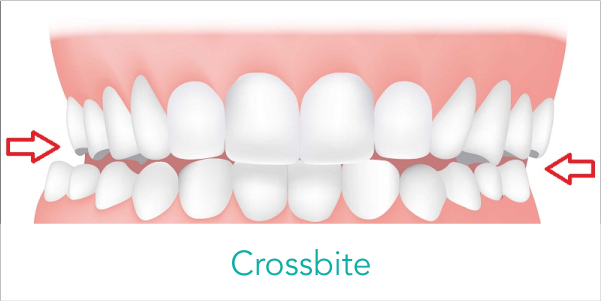Crossbite is a form of malocclusion where a tooth (or teeth) has a more buccal or lingual position (that is, the tooth is either closer to the cheek or to the tongue) than its corresponding antagonist tooth in the upper or lower dental arch. In other words, crossbite is a lateral misalignment of the dental arches.
Terminology and classification of Crossbite
Crossbite can involve a single tooth or a group of teeth. It can be classified in anterior or posterior and bilateral or unilateral.
An anterior cross bite can be referred as negative overjet, and is typical of class III skeletal relations (prognathism).
Posterior crossbite is often correlated to a narrow maxilla and upper dental arch. A posterior cross-bite can be unilateral or bilateral. Unilateral cross-bite often determines a lateral shift of the mandibular position, which can become structural if left untreated for a long time during growth, leading to skeletal asymmetries. There are 3 types of crossbite : simple anterior, functional anterior, and skeletal anterior
Posterior crossbite is also known as “reverse articulation”.
What is A Crossbite?
Crossbites are when the jaw does not properly align. A typical alignment would mean the top teeth are slightly over the bottom teeth. However, with a cross bite, the mandibular (lower) jaw could be jutted too far forward, causing an underbite, or the maxillary (upper) jaw could protrude too far forward, resulting in an overbite. When a cross bite occurs, it could contribute to a variety of issues with your mouth, teeth, jaws, and even your head or neck. A crossbite not only can be aesthetically unpleasing, but also can interfere with the ability to properly masticate (chew) your food. If we’ve said it once, we’ll say it again- our mouth is a large contributing factor to our overall health. If you aren’t able to properly chew your food, you may be robbing your body of nutrients necessary to maintain a healthy lifestyle. If you have a crossbite, you may also notice popping or clicking sounds in your jaw joints when you open and close your mouth. When the jaw is improperly aligned, it can lead to unwanted pain of the mouth, head, and neck.
Misaligned jaws can also contribute to neck pain and headaches, specifically migraines. You may not be concerned with how straight your teeth are, but if it interferes with your life by causing headaches, you may want to consider treatment to correct your crossbite and misaligned jaw. A crossbite can also cause problems that you may not even be aware of yet. If a crossbite is not corrected, it can lead to worn down teeth, gum disease, and bone loss. Worn down teeth are more susceptible to developing cavities or tooth sensitivity. Correcting a crossbite that is yielding these aforementioned symptoms is important in preventing further damage to your teeth, gums, and jawbone.
There are various methods of treatment available to correct a crossbite. Keep in mind that your dentist will recommend treatment based on your specific case. A common method of treatment is orthodontics, specifically braces. For mild cases of crossbite, ClearCorrect braces may be recommended. ClearCorrect braces are clear and basically invisible. They are typically made from plastic and fit comfortably over your teeth after taking a mold of your mouth. ClearCorrect braces are also removable and generally ideal for adults. However, depending on the severity of your crossbite, you may not be an ideal candidate for ClearCorrect. In fact, for some individuals, a combination of treatments may be used in correcting a crossbite. There are also what is known as traditional metal braces that are available to correct a crossbite. Since a crossbite can often be caused by overcrowding, sometimes a dentist will recommend extracting certain teeth and then use orthodontics to straighten out the existing teeth and correct the cross bite. In some extreme cases, jaw surgery may be necessary to help correct a crossbite. Using orthodontics to correct a crossbite can be a slow progression over the span of months to years, depending on the severity of the crossbite. Your dentist can develop a specific treatment plan just for you.
A consultation will usually allow the dentist to gather information about your crossbite and about the symptoms you maybe experiencing. Be sure to let you dentist know about any jaw, head, or neck pain you are experiencing that could be contributed from a cross bite. An individualized treatment plan will designed for you that addresses modality of treatment, duration, and cost. Most dentist offices will offer a payment plan that is suitable for almost any budget. Be sure to discuss options for payment ahead of time so that once you begin treatment, you can complete what you’ve started and be on your way to a healthy, beautiful smile. It’s never too late to achieve the smile you always wanted!
Thanks for reading this content of Dr. Sheibani Nia’s website, best orthodontist in Iran.


بدون نظر